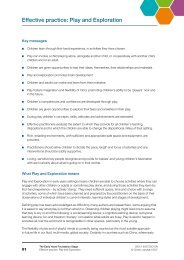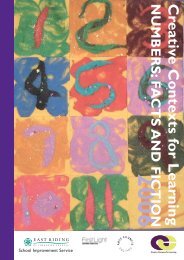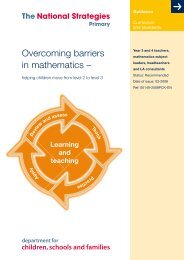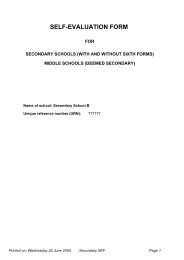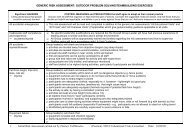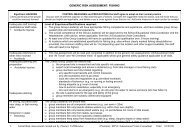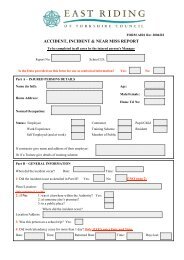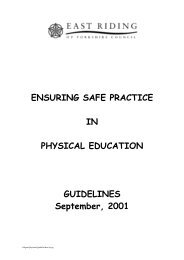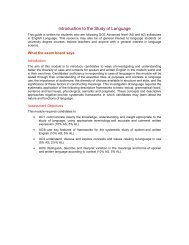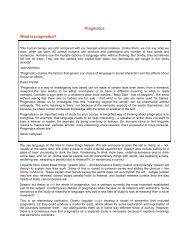Caving - eRiding
Caving - eRiding
Caving - eRiding
You also want an ePaper? Increase the reach of your titles
YUMPU automatically turns print PDFs into web optimized ePapers that Google loves.
GENERIC RISK ASSESSMENT: CAVING AND UNDERGROUND EXPLORATION<br />
Significant HAZARDS<br />
Likely places/ways that people<br />
could be seriously harmed<br />
All caving activities<br />
Inadequate<br />
staff training, qualifications,<br />
and ratios<br />
Accidents/ Injuries<br />
CONTROL MEASURES and PRECAUTIONS that staff agree to adopt as their normal practice<br />
Discuss with all staff that organise or help lead this type of activity. Consider the suggested measures below, and tick those that you<br />
decide are helpful and applicable, and delete or put a cross against those that are not. Add extra measures in each section as needed.<br />
Level of Experience/Qualifications required:<br />
(see Technical Competence/Qualifications matrices in Appendix for further details)<br />
In addition to evidence of recent and relevant experience, the leader must hold an appropriate National <strong>Caving</strong><br />
Association qualification for the system and the route they intend to lead (a minimum of Local Cave Leader), and be<br />
approved by the LEA Educational Visits Consultant(with appropriate advice from a technical adviser holding a <strong>Caving</strong><br />
Instructor Certificate (CIC)).<br />
Instructor/Student ratios required:<br />
Min. 1 (plus an additional competent adult) : 12 recommended<br />
This risk assessment will be read and completed in addition to the generic risk assessments “All Educational Visits”<br />
and “All Travel” and “All Overseas Visits” (if applicable) which give general safety guidance applicable to all visits.<br />
All caving activities<br />
Inadequate<br />
preparation and planning<br />
Accidents/ Injuries<br />
All caving activities<br />
Inadequate planning/maps and<br />
knowledge of venue<br />
Group lost<br />
Injuries / Hypothermia<br />
Setting up ropes by the<br />
instructor<br />
Slips/ Falls by the instructor<br />
Slips/Falls by group members<br />
The Overall Group Leader/Instructors will ensure that:<br />
the proposed route(s) has been specifically risk assessed<br />
the proposed route(s) is included in the leaders list of approved caves/mines in LCMLA logbook page (unless CIC<br />
holder).<br />
the Leaders continually assess and respond to risk throughout<br />
the Leader has uptodate local knowledge/advice from appropriate local caving organisation (e.g. PICA/DCA etc) or<br />
CIC holders about system<br />
the proposed route is suitable for the ability and experience of all group members<br />
old mineral mines are used with extreme caution and only those sites inspected by NAMHO<br />
a detailed record of the route(s) is left with the emergency home contact<br />
an expected time of return is left with the emergency home contact<br />
the emergency home contact has clear written emergency procedures for all circumstances, including if the group is<br />
overdue<br />
<br />
The Overall Group Leader/Instructors will ensure that:<br />
group leaders have an adequate number of detailed maps of the caving system (including reserve copies)<br />
they have sufficient previous experience of and familiarity with the proposed routes<br />
they are aware of likely areas of difficult navigation (e.g. awkward junctions)<br />
group members and leaders carry suitable spare clothing and emergency survival equipment<br />
<br />
The Overall Group Leader/Instructors will ensure that:<br />
instructors are always appropriately protected whilst setting up belays and working near the edge at the top of caves<br />
group members are properly supervised whilst instructor is engaged setting up ropes etc.<br />
<br />
1 Initial Risk Assessment carried out by (Name): Taff Bowles (Position): ERYC Educational Visits Consultant Date: 01/09/09
GENERIC RISK ASSESSMENT: CAVING AND UNDERGROUND EXPLORATION<br />
Significant HAZARDS<br />
Likely places/ways that people<br />
could be seriously harmed<br />
CONTROL MEASURES and PRECAUTIONS that staff agree to adopt as their normal practice<br />
Discuss with all staff that organise or help lead this type of activity. Consider the suggested measures below, and tick those that you<br />
decide are helpful and applicable, and delete or put a cross against those that are not. Add extra measures in each section as needed.<br />
Equipment failure<br />
Injuries<br />
All caving activities<br />
Falls from height, Objects<br />
(rocks and equipment) falling<br />
from above<br />
Holes in floor,<br />
Trips and slips<br />
Injuries<br />
The Overall Group Leader/Instructors will ensure that:<br />
all equipment is cleaned, maintained and checked regularly<br />
any damaged or worn equipment is disposed of and replaced (N.B. substandard equipment must not be stored near<br />
other caving equipment and it must be clearly marked as no longer for caving use)<br />
a log is kept of equipment usage and its condition (including any repairs/replacements)<br />
all participants are briefed regarding the correct usage and treatment of equipment<br />
a visual check of equipment is made at each use<br />
all harnesses and helmets are checked for correct fit by the instructor - initially and regularly during the session,<br />
especially before starting any climb/abseil<br />
rope rigging systems allow for the minimum friction/ wear on ropes and will be protected from sharp edges<br />
suitable and sufficient anchors/belay points are used in the setting up of climbs and abseils (N.B. a system of multiple<br />
anchors is always preferable to a single anchor)<br />
all caving lamps are fully maintained and charged<br />
reserve lighting is available should a lamp fail<br />
<br />
The Overall Group Leader/Instructors will ensure that:<br />
group members are informed about and follow correct caving procedures and calls<br />
group members are briefed initially regarding hazards, safe practice, and any no-go areas<br />
the route can be effectively and safely supervised and monitored by the Leaders<br />
only appropriately qualified/competent leaders set up and change the belays/rope systems<br />
belayers are trained and assessed as competent and reliable before allowing them to belay without direct supervision<br />
belayers are reminded at frequent intervals to stay focussed and to concentrate on their own climber’s needs<br />
appropriate belaying systems/devices are used, according to the age/sizes/weights and competences of the group<br />
backup belayers are used if appropriate<br />
the belayers are supervised and monitored throughout by qualified/experienced Leaders<br />
belayers are briefed to lower climbers at a slow, even pace, with particular care given near ground level<br />
harnesses are securely fastened and checked by the Instructor/Assistant Leaders at the start of the climbing session,<br />
and after any rest period where harness may be removed/altered<br />
karabiners are closed/locked/checked before each and every climb<br />
helmets are worn at all times<br />
ropes are correctly tied/attached into harnesses (and checked by Leaders) using the method recommended by the<br />
harness manufacturers<br />
group members are wearing suitable footwear with a good grip<br />
the abseil rope is always checked to ensure that it reaches the ground<br />
separate anchors are used for the abseil rope and the safety rope<br />
2 Initial Risk Assessment carried out by (Name): Taff Bowles (Position): ERYC Educational Visits Consultant Date: 01/09/09
GENERIC RISK ASSESSMENT: CAVING AND UNDERGROUND EXPLORATION<br />
Significant HAZARDS<br />
Likely places/ways that people<br />
could be seriously harmed<br />
CONTROL MEASURES and PRECAUTIONS that staff agree to adopt as their normal practice<br />
Discuss with all staff that organise or help lead this type of activity. Consider the suggested measures below, and tick those that you<br />
decide are helpful and applicable, and delete or put a cross against those that are not. Add extra measures in each section as needed.<br />
After heavy or prolonged<br />
rainfall<br />
Flooding<br />
drowning<br />
Quality of Air/Water<br />
Air (Radon Gas) / Water<br />
Pollution<br />
illness<br />
Weil’s disease<br />
Cold temperatures (including<br />
surface hazard)<br />
Hypothermia<br />
<br />
<br />
<br />
<br />
instructors are always able to free themselves from their belay system to help with emergencies<br />
correct techniques for abseiling and climbing are taught<br />
for individuals at risk of falling out of their harness if they invert, a chest harness will also be used<br />
The Overall Group Leader/Instructors will ensure that:<br />
note is taken of weather conditions in the days preceding<br />
an uptodate weather forecast is obtained on the day prior to departure<br />
expert detailed local advice is obtained where appropriate<br />
emergency escape routes are planned beforehand<br />
the activity is cancelled or adapted if flooding is a likely threat<br />
the group returns to the surface immediately should water levels begin to significantly rise whilst they are underground<br />
entering /diving any sumps will be avoided<br />
<br />
The Overall Group Leader/Instructors will ensure that:<br />
group members have suitable protective outer clothing<br />
group members are briefed regarding hygiene<br />
parents and young people are briefed regarding Weil’s disease and the action to take if signs/symptoms show<br />
the length of exposure in areas of known high radon is limited<br />
group members are briefed to cover any cuts/wounds before trip<br />
<br />
The Overall Group Leader/Instructors will ensure that:<br />
the length and commitment of the proposed route is appropriate for all members of the group<br />
group members have adequate protective clothing and equipment<br />
group members and leaders carry suitable spare clothing and emergency survival equipment<br />
the surface water temperature (if active stream cave) is taken into account in the planning<br />
<br />
Illness or injury<br />
The Overall Group Leader/Instructors will ensure that:<br />
there are sufficiently trained in first aid and emergency procedures<br />
information about existing medical conditions are known by staff<br />
accident and emergency procedures are understood by all leaders<br />
suitable first aid equipment is carried by the group<br />
<br />
Additional hazards? Additional precautions?<br />
3 Initial Risk Assessment carried out by (Name): Taff Bowles (Position): ERYC Educational Visits Consultant Date: 01/09/09
GENERIC RISK ASSESSMENT: CAVING AND UNDERGROUND EXPLORATION<br />
Staff Agreement: “I have read and understood this risk assessment, and I agree to adopt as standard the control measures and precautions stated above”<br />
Staff name<br />
(continue list overleaf if required)<br />
1.<br />
2.<br />
3.<br />
4.<br />
5.<br />
6.<br />
7.<br />
8.<br />
9.<br />
10.<br />
11.<br />
12.<br />
13.<br />
14.<br />
15.<br />
16.<br />
17.<br />
18.<br />
19.<br />
20.<br />
Job title Sept 2009 – 10<br />
(Initials/date)<br />
Sept 2010 – 11<br />
(Initials/date)<br />
Sept 2011 – 12<br />
(Initials/date)<br />
Sept 2012 – 13<br />
(Initials/date)<br />
Sept 2013 – 14<br />
(Initials/date)<br />
Generic Risk Assessments<br />
• Purpose - to encourage staff to identify likely hazards, agree good practice, and apply consistent standards. Follow suggested procedure below (or similar):<br />
• Select and print off - all relevant and helpful forms (according to the type of visits and activities normally organised during the year) – others (e.g. that apply to one-off visits) can be added later if required.<br />
• How many? - one set of forms for small staff teams - or one set per department for large staff teams.<br />
• Complete draft forms - initially by one or two staff with appropriate experience;<br />
• Staff meeting 1 - introduce and leave draft forms in a file for all relevant staff (i.e. those who organise or help lead such visits) to inspect and consider over a short period (e.g. a week).<br />
• Staff meeting 2 - discuss, amend, and agree main hazards and standard practice with all relevant staff (add names and initials in table below to indicate acceptance).<br />
• Staff members who cannot agree with the general consensus should complete their own risk assessment, but this must be agreed and approved by the Headteacher/Manager.<br />
• Check and approve - by line manager/head of dept and/or visits coordinator (add approval signatures in table below).<br />
• Store - in a marked file in a clearly known and accessible place (e.g. staff room or dept office).<br />
• How often? - forms that apply to all visits (e.g. “All Educational Visits”) or to regular/frequent visits (e.g. “Visits to Museums” ) should be completed once, then reviewed, amended, signed and dated annually.<br />
• Additional forms - that apply to occasional/one-off visits (e.g. “Overseas Visits”) can be completed when required – these should be reviewed, amended, signed and dated whenever such visits are planned.<br />
• Keep familiar- with the agreed practice, and refer to forms as a reminder before visits if necessary (especially for activities that are less frequent or familiar to staff).<br />
• New leaders and volunteers - should be asked to read all relevant forms and add their signed agreement before assisting with the organisation or leadership of a visit.<br />
• Review and amend - by all relevant staff annually (or more often if necessary), and immediately if new hazards are identified or new precautions deemed necessary.<br />
• Stop - this type of visit/activity if the level of risk is considered unmanageable and unacceptable.<br />
• Flexibility - may be acceptable on occasion, if staff can reasonably justify their actions.<br />
• Specific Visit Risk Assessment - is also required for each visit to address any extra issues relevant to the specific site/group/activities involved<br />
4 Initial Risk Assessment carried out by (Name): Taff Bowles (Position): ERYC Educational Visits Consultant Date: 01/09/09



